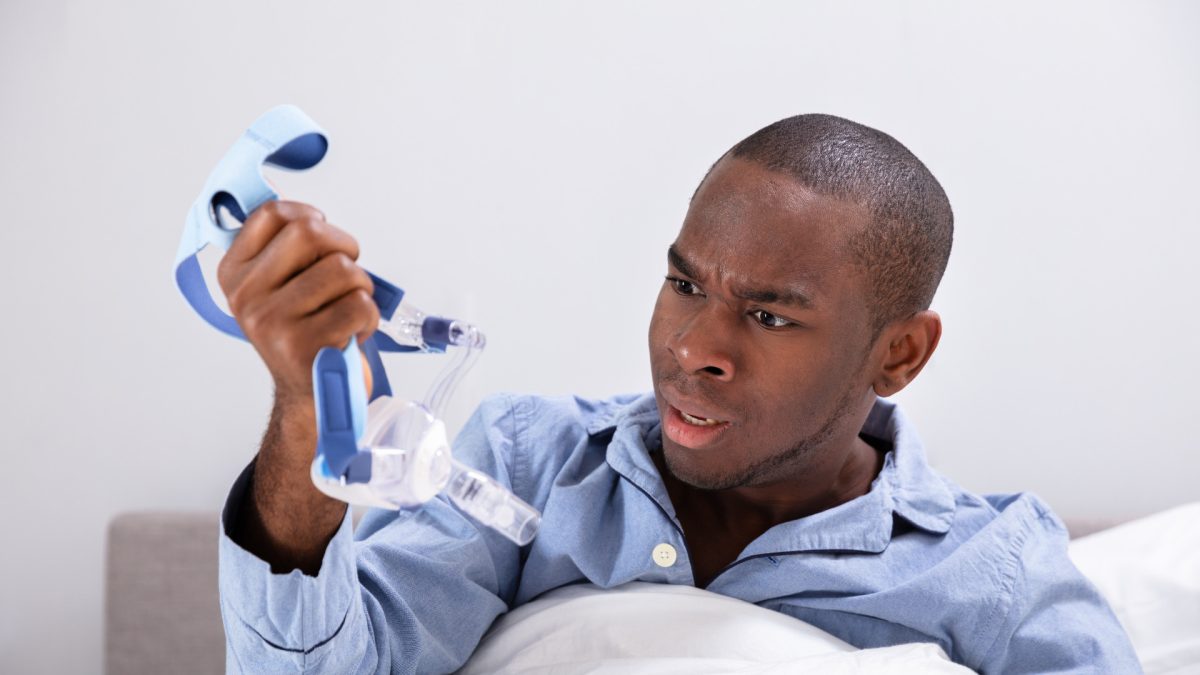Fact Checked
Intus Healthcare’s writers, customer service team, and sleep experts review and ensure this information is accurate.
Last updated on March 13th, 2024 at 10:55 am
Resolving CPAP side effects
Continuous Positive Airway Pressure (CPAP) is the most effective treatment for Obstructive Sleep Apnoea (OSA). Once OSA has been confirmed, your GP or sleep technician will advise the most suitable treatment.
Those with mild, moderate or severe Sleep Apnoea are commonly advised to use CPAP therapy. If you think you have symptoms of Sleep Apnoea, you can take an In-Home Sleep Test to confirm it.
Although the most common treatment option, CPAP therapy can take some time to get used to, and there can be a level of discomfort whilst you tweak your equipment for optimal comfort. Many of the side effects of CPAP therapy overlap, so by solving one problem, you can prevent another.
We’ve created this guide to help you identify potential side effects and ways you can fix them.
Table of Contents
Air Leaks
Your partner may have complained that your mask blows air into their face. This can be caused by an air leak. It’s normal for a small amount of air to escape from your mask, but it shouldn’t interrupt your therapy or your partner’s sleep.
Mask leaks occur when the mask incorrectly fits your face. If you use a mask that doesn’t provide a secure seal, you will likely experience air leaks. Those who wear a mask that is unsuitable for how they breathe will also experience leaks.
Nasal masks are only suitable for those who breathe through their nose. Consider switching to a full-face mask if you breathe through your nose and mouth. Alternatively, if you use a nasal mask and breathe through your mouth, adding a chin strap to your therapy can help keep your mouth closed.
Solution
Nasal masks are only suitable for those who breathe through their nose. Consider switching to a full-face mask if you breathe through your nose and mouth. Alternatively, if you use a nasal mask and breathe through your mouth, adding a chin strap to your therapy can help keep your mouth closed.
Many CPAP manufacturers provider have intelligent apps to tell you how often air leaks happen and how to stop them (ResMed myAir, F&P myMask and Sefam Access). Please be aware that these applications are only compatible with the brand’s specific products.

CPAP mask irritation & red marks
Another common therapy side effect is mask irritation, which can cause red marks and acne. This can make wearing a mask uncomfortable and make continuing therapy difficult. An incorrect-sized mask or style can cause red marks, rashes and acne on the face and around the nose.
If your mask fits correctly and you still have sores and irritation, it could be a silicone allergy. This is called allergic dermatitis and can be solved by wearing a skin-friendly mask that is free from silicone and minimises skin contact.

Solution
You can prevent skin irritation caused by your mask by using mask liners. These soft fabric liners act as a barrier between the skin and the mask and absorb sweat. The liners also work as a comfortable barrier between your skin and mask to create a secure seal.
Nose sores
Nasal pillow masks use two prongs that fit into the nostrils; some people find these to cause sores. However, any type of nasal mask can dry out the nose as the airflow can become too cold, preventing your nose from naturally lubricating.

Solution
You could add a CPAP humidifier to your therapy to prevent nasal sores and irritation by keeping the air moist and warm. Alternatively, a nasal saline spray can also help treat this.
Dryness
Dry nasal passages or a dry mouth can become extremely uncomfortable. It is common in those who breathe through their mouth and use a nasal mask.

Solution
Air leaks could cause you to have a dry mouth from wearing an incorrect mask. Switching to a full-face mask, adding a chin strap or using a humidifier can stop this.
Nasal congestion
If you encounter congestion when using CPAP, you are not alone; this is a common side effect. Again, adding a humidifier to your therapy will help relieve congestion by creating a moist and warm airflow.
To optimise your humidifier, you can add a heated tube to regulate the temperature and humidity levels. If you use a nasal mask, you can also try nasal dilators; these keep your nasal passages open during sleep.

Solution
For those prone to congestion, sinus and nasal care are essential. Nasal irrigation is a proven method of treating congestion, sinusitis, post-nasal drip and allergies. The SinuPulse nasal irrigator is simple to use and affordable.
Claustrophobia
When beginning your treatment, CPAP can be overwhelming. Wearing a mask throughout the night can cause claustrophobia for some users, and it can take up to a month to get used to the treatment.

Solution
However, choose a minimal contact mask if you find your mask too uncomfortable. For example, choose a nasal mask or a less invasive full-face mask, e.g. the Fisher & Paykel Evora or ResMed AirFit F20.
Another way to get used to your mask is by wearing it throughout the day to allow yourself to get used to the feel of it.
Aerophagia
This is a term used to describe burping, bloating and gas caused by air swallowing. Aerophagia is when a person finds it too difficult to breathe against the pressure of their machine.

Solution
This is a term used to describe burping, bloating and gas caused by air swallowing. Aerophagia is when a person finds it too difficult to breathe against the pressure of their machine. Reducing your air pressure levels and switching your sleeping position can stop aerophagia. Using a CPAP pillow allows you to sleep on your side comfortably.
Please note: It is not advised to change your CPAP pressure settings without the guidance of your doctor or sleep specialist.
Headaches
Morning headaches are a symptom of untreated Sleep Apnoea. However, if you wake up with headaches whilst using CPAP, this could be a sign of a sinus infection or blockage.

Solution
Sinus irrigation is an effective therapy for clearing nasal congestion. Explore our sinus and nasal care products for simple sinus relief options.
If your pressure settings are too high, this can also cause headaches.
Ear pain
Using CPAP can cause ear discomfort, usually due to inflammation. Acid reflux, flu and allergies can all cause inflammation in the ear canal.

Solution
If you are prone to ear infections, tinnitus or pain, please ensure the following:
- Your pressure settings are correct
- Your mask has no leaks and fits you. A chin strap can help prevent any leaks from mouthbreathing with a nasal mask.
- Keep your sinuses clear from blockages with nasal irrigation
Respiratory Infections
CPAP users can develop infections due to bacteria and viruses entering the equipment. Other bacteria, such as dust or mould, can also grow in the mask and tube, making an infection more likely.

Solution
If you are prone to upper respiratory infections, please ensure the following:
- Your mask, tube and water chamber are cleaned properly.
- Regularly clean your equipment; if you’re sick, this should be done more often to prevent bacteria buildup and reinfection.
Cleaning and replacing CPAP supplies
Regularly cleaning your supplies is beneficial to get the most from your equipment and prevent side effects. Germs, bacteria and dust build-up can impact the quality of your therapy. Follow your CPAP manufacturer’s instructions for cleaning your supplies, or read our helpful cleaning guide.
The SoClean 2 CPAP sanitiser can make your cleaning routine simpler.
Nothing lasts forever; when signs of wear and tear appear on your equipment, you must replace it. If your mask has begun to cause side effects where it never has before, there’s no need to buy a whole new mask; just find the replacement mask part. If you’re unsure what part you need, you can contact us.
Regularly cleaning your equipment and replacing filters will help you get the most from your machine and prevent many therapy side effects.
CPAP accessories to help combat side effects
Uncomfortable CPAP side effects can be eliminated by adding additional accessories.
Chin strap: The chin strap holds the mouth closed during sleep for those who use a nasal mask and breathe through their mouths. A chin strap helps to prevent leaks and a dry mouth.
CPAP humidifier: Some machines have an integrated humidifier, like the F&P SleepStyle, while others have optional humidification. The humidifier adds moisture to the air to prevent dryness, congestion and discomfort.
Nasal sprays: Nasal congestion is a common side effect; using a nasal spray can alleviate discomfort.
Heated tubing or hose fleece: A humidifier can sometimes cause condensation. Switching to a heated tube or adding a hose fleece keeps the air at a constant temperature to stop condensation build-up, add comfort and reduce noise.
Hose lift: To move more freely during the night, use a hose lift; these prevent tangling in your tubing and pulling on your mask.
CPAP pillow: Your sleeping position impacts your therapy; sleeping on your side is encouraged as it helps to open the airway. Adding a CPAP orthopaedic pillow allows you to sleep on your side without dislodging your mask or suffering from red marks.

CPAP Bedside Table: If you travel with your machine, using a portable CPAP table will make your experience simpler.
CPAP battery pack: To make travelling with your device easy, consider a battery pack to avoid pausing your therapy.
Related articles:
How your sleeping position affects your sleep
Is The So Clean 2 CPAP Sanitiser Safe To Use?
Solving red marks and skin damage from your mask
Find the best supplies for you
It can take time to adjust to CPAP therapy, and the side effects can make it harder. Finding the right CPAP supplies for you can make all the difference.
For helpful guidance and expertise, contact us.




